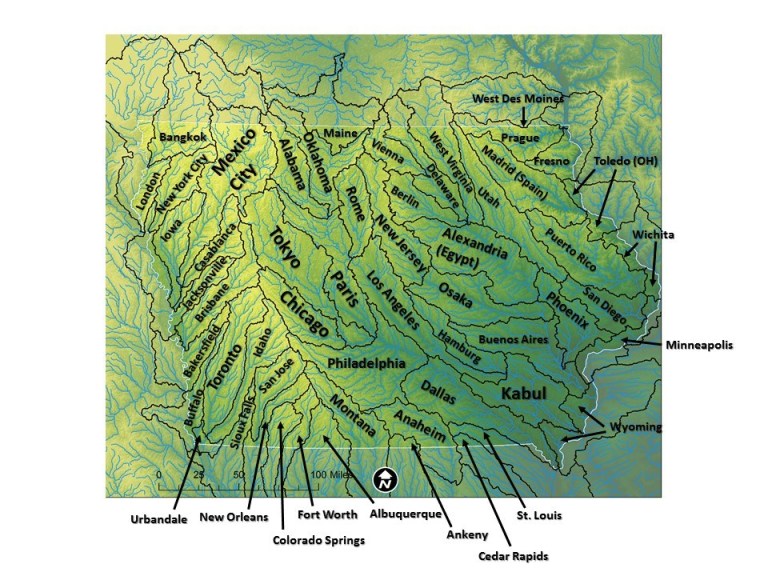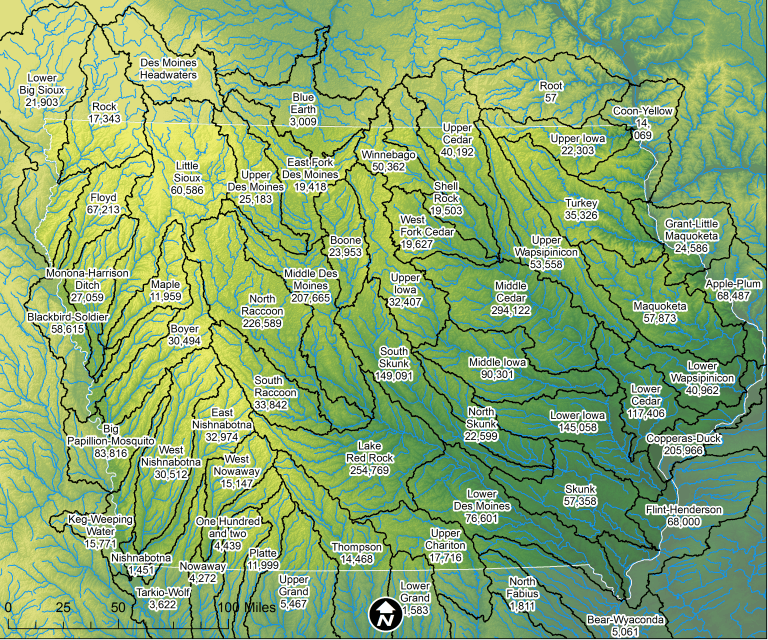Chris Jones is a research engineer (IIHR-Hydroscience and Engineering) at the University of Iowa. First published on the author’s blog. -promoted by Laura Belin
Iowa has around 3 million people, a total that has changed little over the last 80 to 90 years. People are large animals, and as such our bodies produce a lot of waste. That being said, we produce much less waste than the animals that we eat.
Take hogs, for example. A feeder pig is about the same size as a human being, but it excretes 3 times as much nitrogen (N), 5 times as much phosphorus (P), and 3.5 times as much solid matter (TS-total solids) (1). Some of this is because of the pig’s diet and some it is because modern hogs grow really, really fast (these things relate to each other, obviously). A pig weighs about 3 pounds at birth and about 250 pounds at slaughter a mere 6 months later, so it is gaining more than one pound per day.
By comparison, a human infant gains a pound about every 20 days. There’s a reason we use the word “hog” metaphorically and pejoratively because they consume anything and everything in sight virtually non-stop, which is one reason why they make for a good food animal.
Everybody knows Iowa has a lot of livestock. If you’re like me, maybe you have heard from time to time that our state has enough animals to effectively be as populous as California, using one common example. As you will soon see, it’s bigger than that. Much bigger.
Exactly how many of each species that we have at any one time is a difficult thing to quantify for reasons I will not get into here. I’m going to present some watershed-by-watershed numbers for the following analysis and I do not claim that they are exact, but I have consulted with a couple of experts and I am confident they are in the ballpark.
Statewide, we have around 20-24 million hogs; 250,000 dairy cattle; 1.8 million beef cattle, 80 million laying chickens, and 4.7 million turkeys. I did not consider sheep, goats, horses or broiler chickens.
When I apply the N, P and TS values of the waste from these animals, what would be the equivalent-sized human population that would generate such waste is staggering:
In total, these five species generate the waste equivalent to that produced by about 134 million people, which would place Iowa as the 10th most populous country in the world, right below Russia and right above Mexico. (Caveat: obviously Russia and Mexico have their own livestock that I am not counting.) And in terms of population density in the context of N, P and TS waste, Iowa would come close to the country of Bangladesh.
Managing the waste from these animals is possibly our state’s most challenging environmental problem. Of course we have a lot of cropland to apply this waste, but the time windows in which farmers have to do this in without damaging the crops with equipment are usually not large. Wet, cold and hot weather can all limit application. As a result, there are only a precious few weeks in a year when this Mt. Everest of waste can be applied to corn and soybean fields.
And there can be no doubt that the sheer amount, and the logistical complications of hauling and handling it, have consequences for water quality (2). Watersheds with the highest density of livestock frequently have some of the highest stream nitrate concentrations (North Raccoon, Floyd, and Rock River watersheds, for example).
Watersheds are classified by size into what is called a Hydrologic Unit Code (HUC). When evaluating water quality, we frequently look at HUC8 watersheds, which on average are about 1000 square miles. There are 56 HUC8 watersheds in Iowa. My colleague Dan Gilles, a Water Resources Engineer at the Iowa Flood Center, was able to derive the human population for all of Iowa’s HUC8 watersheds.
Our most populated watershed, the Middle Cedar, has 294,000 people. Even in that watershed, the human-equivalent livestock population (3.6 million) dwarfs that of actual people. I added the human population to this human-equivalent livestock population for each of Iowa’s HUC8 watersheds and this is illustrated in map below by relating it to a city or state that has a similar human population. I realize that most people will not know the population of many of these places, and the table that follows will help with that.
To finish up, I present this illustration not to make any value judgments on the livestock industry. Clearly it is an important part of our economy. I think we can and should, however, objectively and dispassionately ask ourselves how much we can accommodate while still being able to achieve our desired environmental outcomes. Denmark and the Netherlands both have livestock densities on the scale of Iowa. As a result, both of these countries have in the past suffered environmental consequences similar to our own, but, both country’s governments have intervened in more forceful ways than ours. I’m not saying this is good, bad, or in between, it’s just true.
I think even industry advocates would say there is not much that limits further expansion in Iowa, except perhaps available land in certain areas of the state to apply the waste. Is it reasonable to think about what’s possible when trying to reconcile our desired environmental outcomes with the economic and regulatory considerations the industry wants? If we are going to be honest with ourselves, then I think the answer to that question is yes.
This map shows the human waste equivalent of the people, hogs, laying chickens, turkeys, and dairy and beef cattle the city or state that relates to it with its human population only. Reflected is an average of N, P and TS waste. Only the population of the city proper is reflected, not the overall metropolitan metro area.
Iowa HUC8 Watersheds and the number of Iowans living in them:
Data table used to derive the maps above:
1. http://agrienvarchive.ca/bioenergy/facts.html#Approximate_nutrient_content
2. Jones, C.S., Drake, C.W., Hruby, C.E., Schilling, K.E. and Wolter, C.F., 2018. Livestock manure driving stream nitrate. Ambio, pp.1-11.
Chris Jones grew up in Ankeny and is a graduate of Simpson College. He also holds a Ph.D. in chemistry from Montana State University. Currently he is a Research Engineer at the University of Iowa. His research focuses on water monitoring and water quality in agricultural landscapes.
Top photo: Hog confinement barn interior, sometime before December 2005, via Wikimedia Commons (originally taken from the U.S. Environmental Protection Agency).
The post Iowa’s real population appeared first on Bleeding Heartland.


